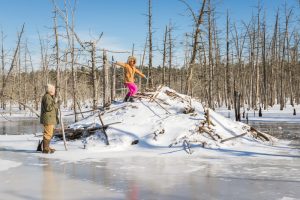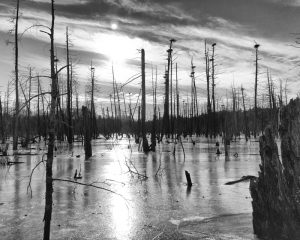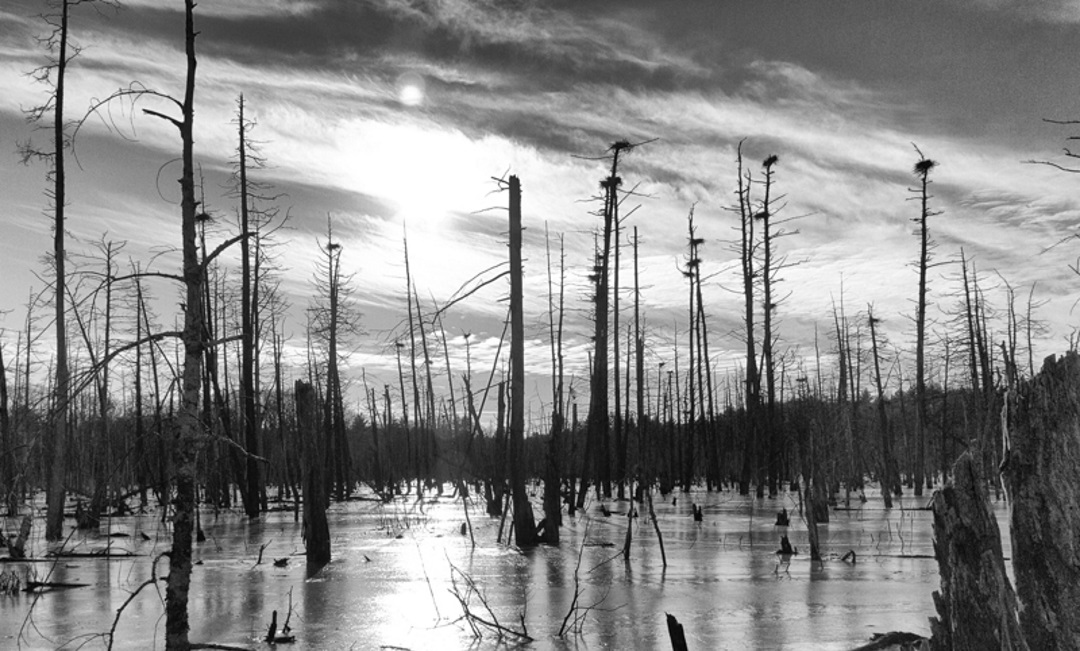Water Closet for January 19, 2018
In the last year of the second millennium beavers found a brook in the northern tip of Middleton. They heard and felt the water flowing out of a large red maple swamp that extended into Boxford and North Andover. In a valley between uplands of ledge above Richardson Farms Second Pasture they built a dam on an old farm causeway that crossed Pond Meadow Brook. The water rose behind their dam and flooded over a hundred acres of wet-footed forest. Dense Atlantic white cedar groves, red maples, and scattered white pines were affected. In the next couple years signs of stress were seen. The scale like leaves of the cedars turned yellow. The red maples’ leaves and twigs began to look peaked. The needles of white pines slowly turned brown. All were dying from too much water all year around over their bases. After about four years the evergreens appeared dead. The maples were losing small branches and shedding bark. The naked pine branches attracted great blue herons looking for nest sites. Six years after the dam a half-dozen nests of sticks were perched on high branches that projected horizontally from the trunks. By 2011 there were 40 nests in about 30 pines, some had two nests. Every year or two the beavers raised and lengthened the dam. It is now 200-feet long and six-feet high. The spreading impoundment above the dam has drowned more trees including oaks growing around the vast pond’s edges. The light pours in unimpeded except behind still standing sun bleached trunks. Unseen insects thrived within the slowly rotting trees. Woodpeckers fattened up on them. The still-standing tree trunks are pocked with their holes.

Queen of the Hill Rachel Schneider exults after pushing the old King (left) off. No beavers emerged from this large lodge in north Middleton to contest her coup. The lodge is 30-feet in diameter at its base under the ice and seven-feet high. – Judy Schneider
For almost two decades, we Stream Teamers, fascinated by the changes, have visited and then reported here in the Water Closet about the transformation of a shady maple swamp to an open “beaver meadow,” which might better be called a huge shallow pond with new soft, light-loving, plants and bushes instead of trees.
What was this swamp like before the return of the beavers in the late 1990s after an over a three-century absence and before a dozen generations of fellow mammals, one-third our size without tools or machines, wrought such dramatic changes? The old Closeteer likes to answer by telling the following story about crossing the swamp before the dam was built.

Stream Team photographer Judy Schneider took several photos of the Pond Meadow Pond beaver impoundment in north Middleton two weeks ago and spliced them together. The 120 or so acres one a shady red maple swamp, is now after 18 years, a vast beaver meadow-pond. The sun-bleached dead tree trunks seen are largely cedars and pines. Most of the drowned maples have fallen. Note the heron nests in the pines. – Judy Schneider photo
It was probably late summer or early fall. Walking in the upland oak woods around the swamp’s edges he noticed it seemed dry enough to attempt a slog across. He decided to beeline SE to NW. He descended and then entered the swamp on the south edge from glacier sculpted high land protected by Greenbelt to the east of Pond Meadow Brook and Second Pasture. He was soon in the dim light of a grove of cedars. Progress was slow over the many fallen logs, hummocks and over roots covered knee deep by spongy layers of peat moss between tree trunks only a few feet apart. He zig-zagged 100 yards up, down and around, to go 30 yards. The numerous intertwining branches above kept out much of the waning afternoon light. Despite growing unease about getting across before dark or exhaustion he thought it too late to turn back. The sun was below the knolls defining the swamp’s western edge. Used to hiking in all kinds woodland conditions, and even in another jungle-like cedar swamp around Aunt Bett’s Pond in central Middleton, he increasingly worried about getting out. Finally, after what seemed an hour, while making only a half-mile as the heron flies, he rose out of the swamp on to familiar upland. An old cart path and then Second Pasture got him easily out to unpaved North Liberty Street.

Puzzle for you. Note the pancake shaped gas bubbles that were sequentially rising in the black ice of an otter access hole in white ice and then frozen in time. How did this striking sequence form? The best explanation received will win a free Stream Team tour of the Pond Meadow Pond beaver impoundment. – Rachel Schneider photo
That scary crossing was before the dam built two decades ago. Since then he has been skirting the once swamp, now beaver meadow/shallow pond several times a year. During winter cold spells he, family and friends cross on the ice. By 2005 all the trees were dead or dying. Without leaves the light poured in. Each year in winter storms, more snow laden corpses have fallen. During dry summers the hundreds of crisscrossed fallen trunks remind the Closeteer of a giant game of pickup sticks on a muddy table of hundred thirty acres. Only the upper layers are seen. Decades of water pickled logs lie below. Above them in the shallow water active life thrives. In summer floating water shield, duckweed and water meal cover the surface. Beneath them plankton is abundant. Fish, turtles, snakes, amphibians, crustaceans, insects, worms have shelter and plenty of food. Nutrients from them fertilize the herbaceous plants. Birds and mammals prosper. The thick organic bottom stratum provides substrate and food for bacteria and fungi. The peat moss the Closeteer struggled through is rotting in the acidic water.

Great blue heron rookery in white pines above ice. – Judy Schneider photo
This winter, deeply cold day after day from December through the first week January, the surfaces of our quiet water bodies froze to depths of a foot. A five-inch Christmas snow on the ice prevented slipping thus rendering the impoundments safe and walkable. Two days after New Years Day when the artic cold abated a bit and the wind dropped, five Stream Teamers visited the once shaded swamp and walked in full light for almost two hours on ice among its wonders: four beaver lodges, two active, two abandoned; windows of black ice that had been kept opened by otters for access, quite a chore in the unrelenting cold; hundreds of tree corpses still standing, others prostate on the ice; a third-mile long colonial farmers’ ditch leading from Pond Meadow Pond to the dam across Pond Meadow Brook, on the map but out of sight under ice; Pond Meadow Pond, a three acre kettle pond about 15 feet deep, with many fish the ice fishermen hadn’t been after yet this winter; 40 heron nests high above in the dead pines; and the list goes on. We never tire of visits on ice to this wondrous place that stretches north to another large beaver impoundment above a large dam in Boxford, and yet another easterly over and beyond a third dam almost to Bald Hill.
We saw no birds or mammals on our visit but there were many signs, especially tracks in the snow that showed the great expanse of ice has much traffic across it at night. We added our wandering-about prints to the mix. Two days later the first blizzard of 2018 made walking there impossible without snowshoes or skis. Now we await a thaw and then cold weather to provide a crust for on foot visits. If you go, be careful, the thick blanket of snow acts as insulation, heat up from the earth below may soften spots. In visiting such places, you are not limited to Middleton’s beaver impoundments. There are now hundreds in New England. The shady red maple swamps of 20 years ago were nothing like the open beaver ponds and wet meadows in the same locations now.
The Middleton Stream Team and Essex County Greenbelt have teamed up for a winter hike on Sunday, 28 January, to the beaver pond described above. However, this event isn’t wholly in their hands. We await as we yearly must for Mother Nature. If she blesses us with good hiking conditions for young and old we’ll go. Visit the Steam Team’s site a few days before the scheduled hike for an announcement.
__________________________________________________________
WATER RESOURCE AND CONSERVATION INFORMATION
FOR MIDDLETON, BOXFORD AND TOPSFIELD
| Precipitation Data* for Month of: | Oct | Nov | Dec | Jan | |
| 30 Year Normal (1981 – 2010) Inches | 4.44 | 4.55 | 4.12 | 3.40 | |
| 2017 Central Watershed Actual | 4.03 | 1.54 | 2.97 | 1.6 | |
Ipswich R. Flow Rate (S. Middleton USGS Gage) in Cubic Feet/ Second (CFS):
For Jan 12, 2018 Normal . . . 52 CFS Current Rate . . .14.8 CFS
——————————————————————
*Danvers Water Filtration Plant, Lake Street, Middleton is the source for actual precipitation data thru Dec..
** Middleton Stream Team is the source of actual precipitation data for Jan.
Normals data is from the National Climatic Data Center.
THE WATER CLOSET is provided by the Middleton Stream Team: www.middletonstreamteam.org or <MSTMiddletonMA@gmail.com>


skmbet hello my website is skmbet
midel hello my website is midel
mbatoto hello my website is mbatoto
sawer88 hello my website is sawer88
Becky G hello my website is Becky G
hikayat hello my website is hikayat
atuslot hello my website is atuslot
Slot XO hello my website is Slot XO
jsEncrypt hello my website is jsEncrypt